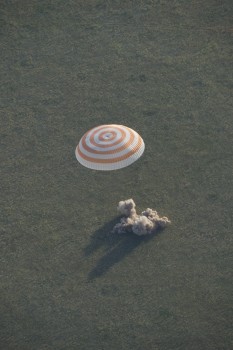
Landing of Soyuz TMA-15M with ESA astronaut Samantha Cristoforetti, NASA astronaut Terry Virts and Russian commander Anton Shkaplerov on 11 June 2015. Credits: ESA–S. Corvaja
Andreas’s iriss mission lasts only ten days so the news that his flight to the International Space Station would take two days instead of the original six hours required many changes to the mission programme.
Eskil from Sweden asked on this blog in the comments why the mission was not extended by two more days to accommodate the full mission plan? We asked Mission Director Roland Luettgens:
The option was discussed by the partners that run the International Space Station but the problem was the landing. Landing a Soyuz spacecraft is an intense affair for everyone involved and the conditions on Earth should be as good as possible. Weather conditions, the position of the Sun in the sky and orbital parameters all play a role in the landing on the steppes of Kazakhstan.
Extending the mission by two days was theoretically possible but the conditions at the landing site were less ideal and more importantly there would be no backup dates for landing. If the weather changes last-minute astronauts in a Soyuz can wait another day before going in to land, but this would not have been possible if the iriss mission had been extended by two days.
Understandably, the International Space Station partners decided this was a risk they were not willing to take.
See what is involved in a Soyuz landing in the video below:


Discussion: no comments